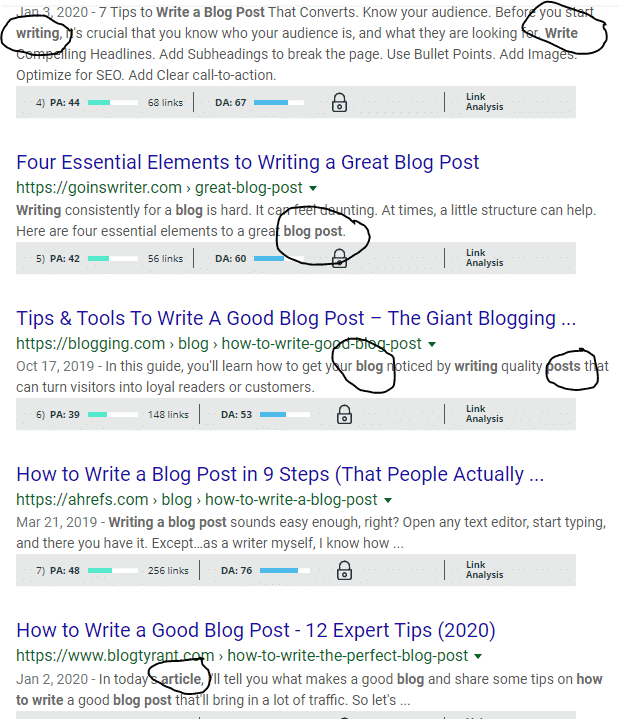In today’s article, I’m going to show you how to write a blog article, how to compose it, how to find keywords that will generate more traffic on your website, help you build your authority, and position yourself on Google.
First, if you write exactly the same blog post for the same website, one is optimized correctly and the other is not. The post that is optimized correctly will get more traffic, which is why you have to make sure your article is well optimized for search engines.
Plan before writing your blog article
Understand the reason why you write
When writing a blog article, remember this: the reason for writing your article is to educate an audience and get global recognition. When you create a blog post, you want the whole world to read it because it increases your authority. So when you create a blog article, your deep intention is not always necessary to sell or pre-sell anything but to educate.
The public does not necessarily have to be a prospect or a potential client. Remember, we are not creating a home page, we are writing an article to explain to readers a new concept or to explore a subject in depth
Brainstorming on the subjects
To make things as simple as possible, I will give you the list of steps to take to get there:
Set the mission for your business
Write the category or mission of your company: what is the purpose of your business? Are you a coaching company, an online store for pet products, a design agency? Whatever you do, write it in the center of a sheet of paper.
How my services can be useful?
Think about how you can help people with what you offer, think about your services, about real problems that your business has solved. And from this central word, create branches for each theme
How can I help solve these problems?
For every word in the industry, think about what you have done to solve these problems for your customers.
For example, We are a digital marketing agency. One of our clients had problems with local search results. So we worked to get him there.
You see the process I’m trying to explain here. Now the idea for a blog article can be “how did we work on this client’s problem and bring it to first place on Google maps
Confirm your list with actual data
After listing your general blog ideas, go to Google and search for the main keyword for each idea.
For example: web design. When searching the Google search bar, do not press the Enter key. Just write a word or expression and wait for the Google automatic completion function. This will give you good ideas for further choosing your topics of articles.
Use allintitle: This will give you all the blog articles that are already in Google and that have the exact title you want to use.
For example: let’s say your keyword is “how to write a blog”. Go to Google and follow what is shown below in the image:
This will help you better understand what works and what does not. You can use these results to find inspiration and data on how to write your own article to make it better than the competition.
Search for keywords
Now that you have a list of ideas and topics you want to talk about that are related to your business. Go to the Google keyword planner and put all your keywords in it. The reason is to have an idea of what the volume of research is for each subject you target. Because you don’t want to write about a subject that no one has ever researched.
The process is simple: Put all the keywords you have in the Google keyword planner (GKP): then see what the search volume is and what are the related keywords appear when you do your search. This will help you adapt your keywords to what people are really looking for before you even invest in writing the best article on a subject that receives no traffic.
Create guidelines
Now that you’ve seen what others are doing, and what really works on Google. I invite you to start writing.
We all know that it is sometimes difficult to write a blog article, either because the subject is too complex, or because your writing skills are not as good as you would like. But this can be overcome by following the following steps:
- Create a plan: a plan is a set of titles, each title would be a part of your article that will discuss a specific point. When you create your title, try to group the same type of ideas in the same title. This will help you write more consistently and convey your message in a more structured way.
- Start by writing some sort of introduction for each part of your content. This means that below each title, I suggest you write one or two sentences that summarize everything you are going to say in this part. These sentences will not necessarily be in the final article. But, it’s just to help you remember what point or points you want to address in each part.

Advice on how to write a better article
You now know what you are talking about, and you have a plan to do it. Therefore, all you have to do next is the trickiest part: write
Here are some simple tips to help you write the best possible content:
Write as you speak
When we write, we tend to overcomplicate the way we convey our messages. We want to look smarter and show that we understand what we are talking about. To do this, you must not complicate reading for the public.
Simplicity is always the key. Most people who read your article don’t want to spend a lot of time trying to understand difficult words and expressions. They want an answer to a problem or question without wasting much time reading a bunch of articles.
Follow the plan
Remember the plan we have already made, follow it. Good content can be divided by titles. No one wants to read a long block of words without a separator. This is why the titles are your friends. You should use the H2, H3 … titles. that will help the reader understand the structure of your article at a glance, and encourage them to read.
And most importantly, sometimes the reader doesn’t want to know everything you’ve written. He just wants an answer to a question. Having titles will make it easier for the public to find what they are looking for and the time spent on the page will increase.
Answer the questions
The main reason someone lands on one of your contents is that they are waiting for an answer. If you don’t have it, it will leave immediately. When writing a paragraph, ask yourself what is the purpose of this paragraph in this blog. Is it a development of something I said, an explanation, or a definition, or am I just trying to fill the word page without thinking about their purpose?
On-page optimization
You now have well-written content, but even if it is the best content on a given subject, if you do not optimize it, it will not be classified in SERP. We are not going to talk about technical or off-page optimization here. All you need is to know the basics of on-page optimization.
- Titles: your H1, H2 … must be optimized. Each of these elements must incorporate a keyword or synonym if possible. Remember, I said if it’s possible. Do not go crazy and try to incorporate words into headers when it is not natural. You don’t want to fall into keyword stuffing.
- Text anchor: your link should normally include your main keyword and should be meaningful and meaningful. Do not take something like: www.example.com/post939
- Images: Images are a great way to convey messages to the public. When using images, make sure your alternative text is optimized.
- Metadata: I’m talking about your title and description. Remember this rule: both must describe what you are going to talk about while being attractive and engaging.

Publish and promote
You have to make sure that your article reaches the greatest number of people. Using social media can be a great way to promote your content and spread the message. Whether it’s organic social media or paid campaigns, these social signals can help your article rank much faster on Google.
Google’s algorithms today take into account the fact that people are talking about the article on social media. Another way social media can help is word of mouth. If you have contacted someone and they share your article, people will be more inclined to read it because it comes from someone they follow and trust.
Updating your content
No one wants to read an article written in 2016 that has not been updated and that talks about the current financial market situation. It is not relevant. People want fresh information that is up to date and contains the latest news and practices.
So make sure you don’t just write your article and leave it. You should always go back to your old content and update it as soon as there is something new so that it does not lose its relevance.
Conclusion
Well, now you know. Writing a blog article is not as difficult as you think. If you only have one plan and one approach, this may be the easiest thing. But remember that it is not easy to become a good editor.
Like any other skill, you must train to achieve perfection. But following this advice, it will be easier for you to start your learning.




